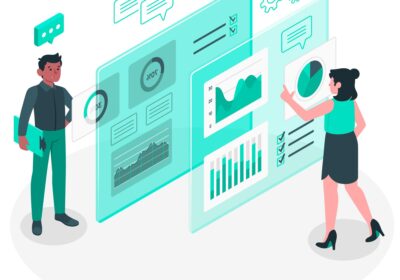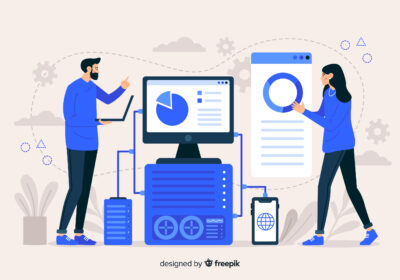Enterprise Resource Planning (ERP) software serves as the central nervous system of many businesses, streamlining operations, integrating data, and boosting efficiency across various departments. Java, with its robust features and platform independence, has emerged as a popular choice for building feature-rich and scalable ERP solutions.
This blog delves into the key considerations and steps involved in developing ERP software with Java, equipping you with the knowledge to embark on this exciting journey.
Why Java for ERP Development?
Java boasts several advantages that make it a compelling choice for crafting ERP software:
- Platform Independence: Java’s “Write Once, Run Anywhere” (WORA) principle allows code written on one platform to function seamlessly on various operating systems like Windows, Linux, and macOS. This eliminates the need for platform-specific development efforts, saving time and resources.
- Robust Object-Oriented Programming: Java’s object-oriented nature promotes modularity and code reusability, making it ideal for building complex and interconnected systems like ERP software. Object-oriented principles like inheritance and polymorphism enable developers to create well-structured code that is easier to maintain and extend over time.
- Large Developer Community and Ecosystem: Java possesses a vast and active developer community, offering extensive resources, libraries, and frameworks to simplify ERP development. Developers can leverage existing solutions for tasks like data access, security, and user interface design, accelerating the development process.
- Scalability and Performance: Java applications are known for their scalability, capable of handling large amounts of data and supporting a growing user base. Furthermore, Java’s performance optimizations ensure efficient resource utilization, crucial for high-volume transactions common in ERP systems.
Key Considerations for ERP Development with Java
Before diving headfirst into code, a well-defined plan is essential for a successful ERP development project. Here are some key factors to consider:
- Understanding Business Needs: The foundation of any successful ERP system lies in a thorough understanding of the specific business needs it aims to address. Carefully analyze the various departments within the organization and identify the functionalities each department requires. This could include modules for inventory management, customer relationship management (CRM), human resource management (HRM), accounting, and financial management.
- Technology Stack Selection: While Java forms the core, a comprehensive ERP solution requires additional technologies. You’ll need to choose a database management system (DBMS) to store and manage ERP data. Popular options include MySQL, Oracle Database, and PostgreSQL. Additionally, consider frontend frameworks like JavaServer Faces (JSF) or Spring MVC to design user-friendly interfaces for interacting with the ERP system.
- Security and Data Integrity: ERP systems house sensitive business data; hence, robust security measures are paramount. Implement secure authentication mechanisms, data encryption techniques, and access control protocols to safeguard sensitive information. Regular security audits and vulnerability assessments are also crucial to identify and address potential security risks.
Developing Your ERP Software with Java: A Step-by-Step Approach
Once you have a clear understanding of your business needs and technology stack in place, the development process can commence:
- System Design and Architecture: Define the system architecture and design the overall structure of your ERP software. This involves outlining the different modules, data flow between modules, and communication protocols. Utilize tools like UML (Unified Modeling Language) diagrams to visually represent the system design.
- Data Modeling: Design the data model that will store all the ERP data. This involves defining entities (e.g., customers, products, orders), their attributes (e.g., customer name, product details, order quantity), and the relationships between these entities. A well-designed data model ensures efficient data storage, retrieval, and manipulation within the ERP system.
- Core Module Development: Start developing the core modules of your ERP system based on the identified business needs. This could involve building modules for inventory management, sales order processing, invoicing, and financial reporting. Utilize Java libraries and frameworks to expedite development and ensure code reusability.
- Integration and Testing: Integrate the various modules into a cohesive system, ensuring seamless data flow and functionality across departments. Rigorous testing is crucial at every stage of development to identify and rectify bugs and ensure the ERP system functions as intended. Implement unit testing, integration testing, and user acceptance testing to guarantee a robust and reliable system.
- Deployment and Maintenance: Deploy the developed ERP system to a production environment, ensuring proper configuration and security measures are in place. Regular maintenance and updates are essential to address any emerging issues, incorporate new features, and maintain the overall health and performance of the ERP system.
Additional Tips for Success
- Leverage Open-Source Solutions: Numerous open-source ERP frameworks built on Java can provide a solid foundation for your ERP development project. Frameworks like Openbravo, Adempiere, and ERPNext offer pre-built modules and functionalities, reducing development time and effort. However, it’s crucial to assess the specific features and capabilities of each framework to ensure alignment with your business requirements.
- Prioritize User Interface (UI) and User Experience (UX): A well-designed user interface is essential for user adoption and efficient utilization of the ERP system. Focus on creating an intuitive and user-friendly interface that caters to diverse user needs and skill levels. Prioritize clear navigation, informative dashboards, and a consistent design aesthetic throughout the system.
- Scalability and Future-Proofing: Design your ERP system with scalability in mind. Choose technologies and architectures that can accommodate future growth in data volume, user base, and business complexity. Modular design with well-defined interfaces between components allows for easier expansion and integration of new modules as business needs evolve.
- Integration with External Systems: Modern businesses often rely on a variety of software applications. Ensure your ERP system can integrate seamlessly with these external systems, such as CRM platforms, e-commerce solutions, and business intelligence tools. Utilize industry-standard integration protocols like APIs (Application Programming Interfaces) to facilitate smooth data exchange between your ERP system and other applications.
Conclusion: Building a Robust ERP System with Java
Developing a comprehensive ERP system with Java requires careful planning, a well-defined technology stack, and a skilled development team. By understanding your business needs, leveraging Java’s strengths, and following a structured development approach, you can create a robust and scalable ERP solution that empowers your organization with improved efficiency, data-driven decision making, and a competitive edge in the marketplace. Remember, successful ERP implementation is an ongoing journey. Continuously monitor and refine your system based on user feedback and evolving business needs to ensure it remains a valuable asset for your organization’s long-term success.





